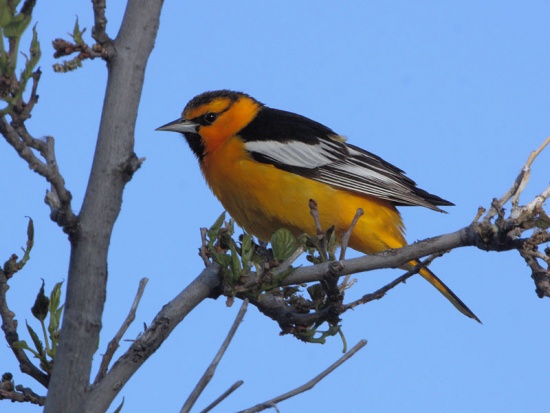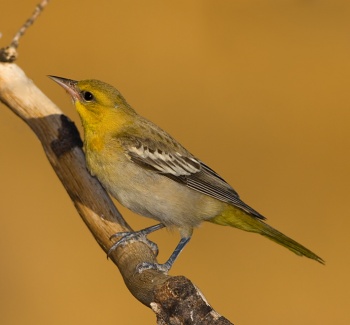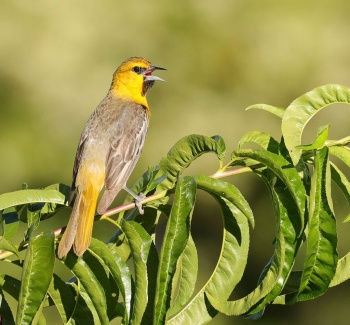- Icterus bullockii
Identification
19–23 cm (7½-9 in)
Male
- Deep orange
- Black wings, back, and tail tips
- White wing patches
- Black cap
- Black line through the eye
- Black throat patches
Female
- Grey-brown upper parts
- Yellow throat and breast
- Whitish underneath
- Two white wing bars
First-year male: black throat and eye-line
Distribution
Breeds from southern British Columbia, southern Saskatchewan, Montana, and southwestern North Dakota south to western Texas and northern Mexico. Winters in Mexico south to Costa Rica. Accidental vagrant in the eastern United States and Venezuela.
Taxonomy
The Bullock's Oriole was once combined with the eastern counterpart Baltimore Oriole as a single species, the Northern Oriole, because they began to interbreed on the Great Plains, when the two forms extended their ranges and met. This is in spite of these two forms not being each others closest relatives.
Subspecies
Two subspecies are recognized[1]:
- I. b. bullockii:
- south-western Canada to northern Mexico, migrates to north-western Costa Rica
- I. b. parvus:
- Extreme south-western USA to northern Baja California and north-western Sonora, migrates to Guerrero
Habitat
Riparian, creek willow and cottonwood, scrub and cactus, Chaparral, mixed oak and pine woodlands.
Behaviour
Diet
The diet includes insects, berries and nectar. They will visit feeders and love grape jelly.
Breeding
The nest, located in a tree, is a pendulous basket, made from hair, twine, grass, and wool, lined with plant-down, hair, or feathers and suspended from a thin branch, overhanging over water. The 4 to 5 eggs are incubated by the female for about 11 days; the young fledge about 14 days later.
The male will tend to the young after they leave the nest. The female, when the conditions are conducive for it, will establish a second brood. This is an evolutionary adaptation that ensures, through greater numbers, that the probability of survival of the species is ensured.
References
- Clements, J. F., T. S. Schulenberg, M. J. Iliff, S. M. Billerman, T. A. Fredericks, J. A. Gerbracht, D. Lepage, B. L. Sullivan, and C. L. Wood. 2021. The eBird/Clements checklist of Birds of the World: v2021. Downloaded from https://www.birds.cornell.edu/clementschecklist/download/
- Birdweb
- BirdForum Member observations
- Birdforum thread discussing the Taxonomy of New World Orioles
- Birdforum thread discussing the hybridization in "Northern Orioles"
Recommended Citation
- BirdForum Opus contributors. (2025) Bullock's Oriole. In: BirdForum, the forum for wild birds and birding. Retrieved 11 May 2025 from https://www.birdforum.net/opus/Bullock%27s_Oriole
External Links
GSearch checked for 2020 platform.1







